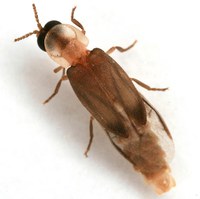Research Initiative Brings Light to Fireflies in New Mexico and Beyond
March 26, 2021 - Fireflies light up the night skies, but little has been known about their populations and conservation challenges—until now. A joint effort between the Xerces Society for Invertebrate Conservation and the ABQ BioPark Species Survival Hub, which is funded by the New Mexico BioPark Society, recently found that 11 percent of North America’s 128 firefly species are threatened with extinction.
Anna Walker, species survival officer for invertebrates at the ABQ BioPark, is part of the International Union for Conservation of Nature’s (IUCN) Species Survival Commission Firefly Specialist Group and has contributed to the project for the last year and a half. This week, the group’s assessments were published on the IUCN Red List of Threatened Species.
“These assessments—the first for fireflies—lay the groundwork for firefly conservation in the US and Canada,” said Candace Fallon, a senior conservation biologist at the Xerces Society and Red List co-assessor in the official press release. “With this information, we can now be more strategic about setting conservation priorities and addressing data gaps, working to protect the full diversity of fireflies and their habitats, from the common and widespread Big Dipper to the threatened and little-known Southwest Spring firefly.”
Compared to populations in eastern states, New Mexico fireflies are rare, Walker said, adding that they require moist conditions to keep eggs and larvae from drying out. The American Southwest is home to at least 25 firefly species and two subspecies, mostly glow-worm and dark firefly species. Only a few of the more widely recognized flashing firefly species occur here. In the Southwest, you’re most likely to come across fireflies in small, scattered populations along waterways, near seeps or in montane marshes.
According to Walker, New Mexico is likely home to several flashing firefly species, but only a few occurrences have been documented. It is unclear which species live in New Mexico, she said, adding that it’s possible the state has at least one species new to science.
“Due to a lack of surveys in the state, the firefly fauna generally is not well known,” Walker said. “For example, five out of the nine New Mexico species assessed were Data Deficient, meaning we do not have enough data to determine the risk of extinction. Due to threats such as drought, mismanagement of water resources, habitat loss and light pollution, it is quite possible that some of New Mexico’s little known firefly species are in decline.”
Starting this summer, the ABQ BioPark will begin working with the Western Firefly Project, a community science initiative pioneered by the Natural History Museum of Utah, to discover more about New Mexico’s firefly fauna.
“With the help of community scientists across the state and region, we hope to map occurrences of rare flashing fireflies so that we can begin to understand what species we have here and how best to protect them for many generations to come,” Walker said.
More information about the assessment can be found here: https://xerces.org/blog/iucn-red-list-assess-fireflies

